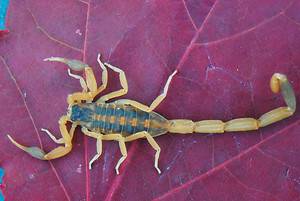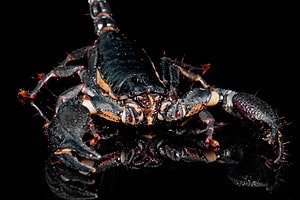Menacing, adaptable, and venomous are three words to describe scorpions. These predators belong to the Arachnida class and order Scorpiones. Spiders, Daddy longlegs, ticks, and mites are other well-known members of the class Arachnida.
Scorpions have existed on Earth for a long time; their evolutionary history dates back more than 400 million years. There are about 15,00 identified species, and the United States is home to approximately 40.
They have evolved to a variety of environmental situations and are survivors. They are on every continent except Antarctica. Their geographic range in the United States includes the South and Southwest.
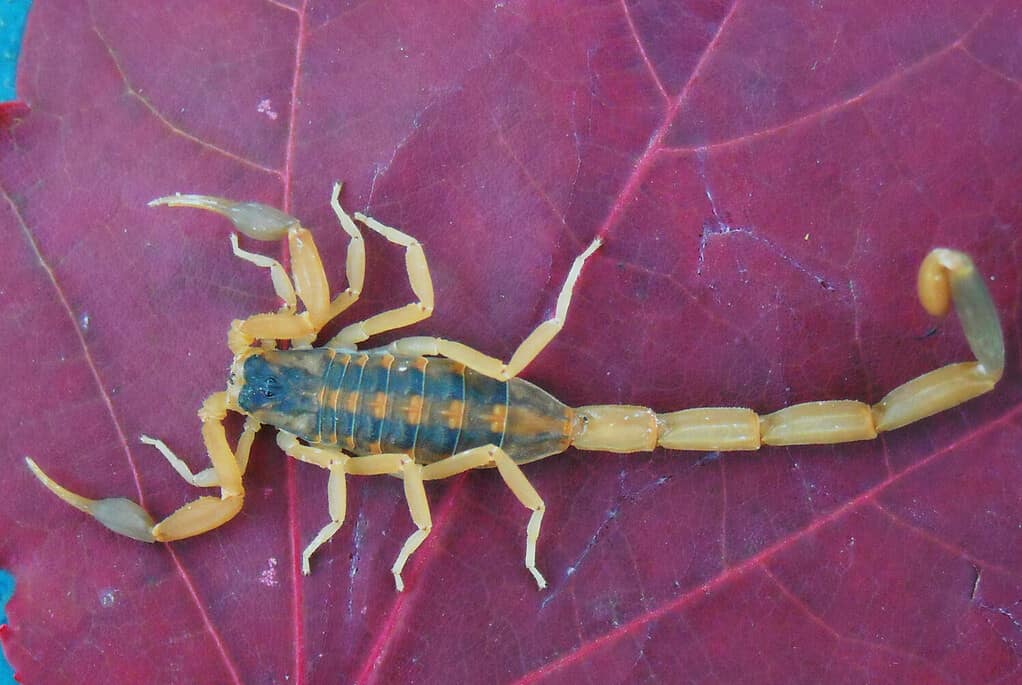
Striped Bark Scorpions are pale yellowish brown, usually with two lengthwise dark stripes on the abdomen.
©Matt Levi Media/Shutterstock.com
Features
Scorpions have eight legs and two primary body parts: the prosoma and the opisthosoma (abdomen). Two eyes are on top of the prosoma, and each side of the body features two to five lateral eyes (up to five pairs). They have poor vision, despite having many eyes.
Their eyes typically distinguish light from dark and movement from stillness. However, their eyes have some of the highest sensitivity levels compared to other arthropods. This sensitivity is based on the types of habitats they inhabit.
Scorpions navigate by using sensory organs in their legs. All scorpions have paired, mid-ventral organs known as pectines. The comb-shaped pectines are behind the walking legs and brush the ground as a scorpion moves.
Pectines have other uses; male scorpions use them to locate females open for mating, and young scorpions use them to identify their mothers.
Although scorpions don’t actually have a “tail,” scorpions do have an extension of their abdomen that resembles one, known as the metasoma. This is where their infamous venom glands and sharp stinger live.
Habitat
Most scorpions are in arid, dry regions. Some species, however, are in the woods, grassy meadows, and caves. They are commonly under wood piles, rocks, or other ground covers. Some prefer to burrow underground in burrows that they dig themselves or ones that they take over from other animals.
Typically, their burrows are compact and cozy. Scorpions use shelters like burrows to avoid being seen by predators, keep cool on hot days, and stay warm on chilly nights. If a scorpion doesn’t dig a burrow, it can find protection by climbing trees or hiding under bark or leaves.
Behavior
Most scorpions reside in the same area for their whole lives and are nocturnal, solitary creatures. Non-mammalian species usually lay eggs, but scorpions are viviparous; they give birth to live offspring. When the eggs are fertilized, the embryos are fed in utero for a few months to a year. The actual birthing procedure could take several hours or several days.
Tropical species give birth all year round, while temperate species do so in the spring and summer. The average litter size is 25.
Exposure to UV light causes scorpions to glow. Their exoskeletons have fluorescent substances that shine in response to UV light. While scientists still don’t know why scorpions glow, they speculate that it might be to lure insects, warn off predators, or create a shadow to find hiding spots.
Up to 45 distinct toxins could be present in scorpion venom. Certain toxins work better on insects, others on crustaceans and vertebrates. Venom is used by scorpions as both a defense mechanism and to immobilize their prey. They are preyed upon by coyotes, owls, bats, hornbills, centipedes, and shrews, among others. Meerkats and mongooses are two of the predators that have resistance to this venom.
Feeding Habits
Scorpions don’t consume food as frequently as we do; they can survive for up to a year without food. They’re okay with only access to water.
Insects, spiders, and other arachnids are common prey. Although less frequently, they also prey on snails, pill bugs, small snakes, and lizards. Producing extra venom requires a lot of body energy, so most scorpions only deploy their poisonous sting when necessary.
Scorpions are opportunistic predators; many wait beside their burrows with their pedipalps open and their stingers up until an unwary prey emerges. The sensitive hairs on their pedipalps enable them to spot and capture an insect in flight. Some dig traps for their prey, while others go out hunting.
Scorpions in Colorado
Scorpionism is a medical condition caused by a scorpion sting, and it can range in intensity from mild to severe. Although only two species with deadly venom are within the United States, it’s always a good idea to know the various species that could be present in your vicinity.
The Centennial State has a diverse scenery that features snow-covered Rocky Mountains, arid deserts, and river canyons. The Southwestern state hosts 3 identified scorpion species. Find out all you need to know about them.
1. Striped Bark Scorpion

Striped bark scorpions have more opportunities to mate and engage in mating competition because they are more social than most scorpion species.
©IrinaK/Shutterstock.com
This is the most prevalent species in the US, with a vast distribution in southeast Colorado and a range that extends as far north as Interstate 70. Striped bark scorpions (Centruroides vittatus) are double-toned arachnids with long, slender bodies. The abdomen is dark brown, while the pincers, legs, and tail are a pale yellow-ivory color.
A V-shaped black area on the head frames the eyes, and light bands run along the body. Males have 21–30 pectinal teeth, whereas females have 20–27. The stinger of the tail has a black pointed tip. The flexible tail, topped with a venom-filled stinger, kills prey after it has been caught in the pincers. A mid-sized striped bark scorpion is usually 2.5 inches long when fully extended.
Their coloring blends nicely with their surroundings, giving them a built-in defense against predators and prey. In its search for prey, the striped bark scorpion prefers to go farther than the other two species in the state. As a result, insects and smaller arachnids make up most of their diet. Its predators include larger arachnids, reptiles, birds, and mammals.
Mating and Reproduction
Striped bark scorpions have more opportunities to mate and engage in mating competition because they are more social than most scorpion species. Mating occurs in the warm season after a dancelike session known as promenade à deux (walk for two). Young are spotted with their mother from May to September, although the time frame in Colorado is from June through August.
Litter sizes of this species typically vary from 13 to 47 offspring. They reach adulthood in 3–4 years and can live for another 2–3 years.
Habitat
Although the striped bark scorpion’s classification in the genus Centruroides suggests that it is a semi-arboreal species, it actually spends a lot of time on the ground. The scorpion leaves its temporary home around or following sunset to hunt for potential prey, continuing its nocturnal preference for the land.
They inhabit different habitats, including temperate grasslands, deserts, and forests. During the day, they can also be seen hiding beneath rocks, fence posts, tent flaps, surface trash, sheds, fallen trees, and barns. They are visible, creeping on the ground, up walls, and around corners. They are also attracted to sinks and bathtubs in homes.
Their Sting
The striped bark scorpion has a reputation for stinging when startled by humans. Typically, this occurs when a hiding place is accidentally discovered. Their venom is generally non-lethal and causes a sting with some swelling. While numbness and irritation may last for some time, the pain usually goes away quite fast.
However, responses to scorpion bites may differ based on individual sensitivities or allergies. Therefore, adults rarely need to go to the hospital. Still, individuals with severe medical conditions or allergies and children stung by this scorpion should do so to manage their discomfort and any reactions.
2. Northern Desert Hairy Scorpion
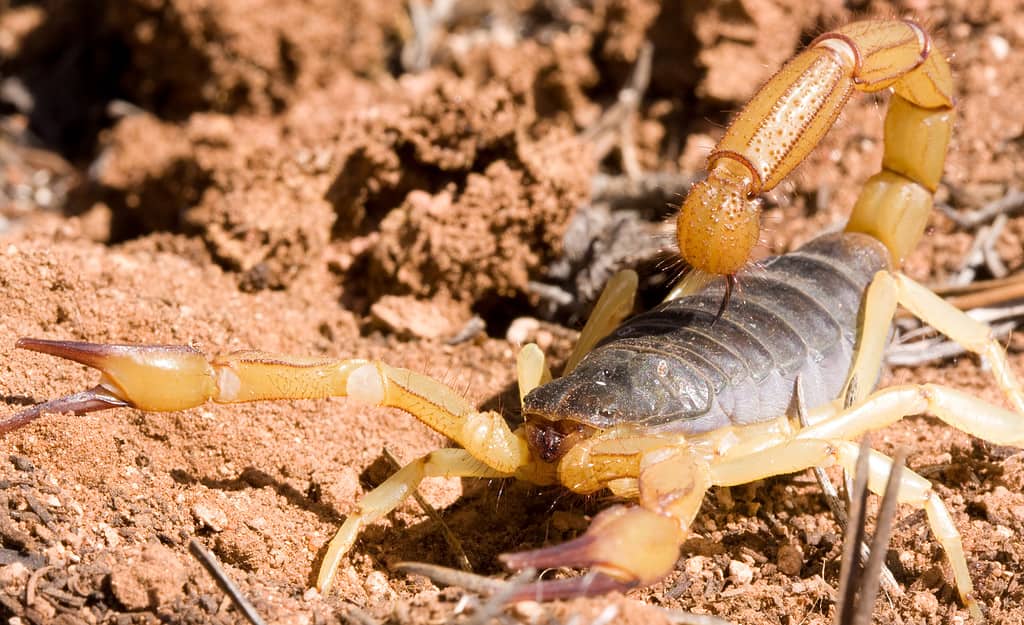
As the name implies, this species has body hairs, which enable it to sense slight vibrations from prey.
©Dave Rock/Shutterstock.com
The northern desert hairy scorpion (Hadrurus spadix), commonly known as black back desert hairy scorpion, is unarguably the biggest scorpion species in Colorado and the entire country. This species is indigenous to the southern deserts of North America and can grow up to five inches long. It has a dark back, but the appendages are light-colored.
As the name implies, this species has body hairs, which enable it to sense slight vibrations from prey. As a result, it has a harder time locating less active prey. However, due to its size, it can catch and supplement its diet with small mice, lizards, and snakes.
Habitat
These scorpions are burrowers, typically found in low-elevation valleys digging intricate burrows up to eight feet long. They enjoy the warm desert regions of Colorado and prefer to stay on the western slope of the Rocky Mountains. The Dinosaur National Monument is one place you may find them in numbers.
Their Sting
These scorpions are quick to sting when given a chance. Though it hurts, their sting has little medical importance. Some people may experience severe reactions, despite not being particularly poisonous to humans.
Look-Alike
With only little changes in color pattern, the Northern Desert Hairy Scorpion (Hadrurus spadix) and the Giant Desert Hairy Scorpion (Hadrurus arizonensis) are nearly identical. The amount and intensity of the black on their heads, around their eyes, and backs are the easiest ways to tell them apart.
Unlike the giant desert hairy scorpion, whose black becomes lighter and less intense as it approaches the head, the northern desert hairy scorpion is completely black up to the eyes.
Pets
Northern desert hairy scorpions aren’t your regular pets, but they can be kept in a separate 2.5-5 gallon-sized terrarium if they’re your preference. Give the bottom 3 to 4 inches (8 to 10 cm) of sand.
Maintain the temperature and humidity in the cage at 75 to 90 °F and 55%, respectively. These scorpions have been known to die if there is too much moisture in the enclosure; thus, moisture levels are quite critical. They can remain in captivity for up to 20 years, living on weekly servings of crickets and other insects.
3. Northern Scorpion
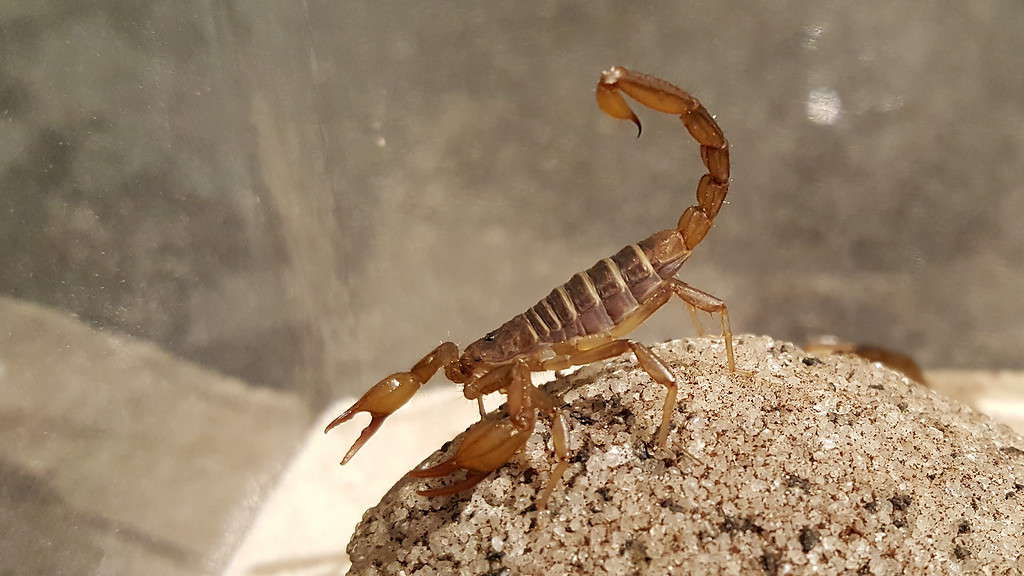
This is the scorpion species with the highest tolerance for cold in Colorado.
©Xbuzzi, CC BY-SA 4.0 <https://creativecommons.org/licenses/by-sa/4.0>, via Wikimedia Commons – License
The northern scorpion (Paruroctonus boreus) is another medium-sized species, ranging from 1.5-2.0 inches long. Typically, it has a dusky back and is pale yellow to orange-brown. Adult males are often much smaller than adult females.
This scorpion has the most northern range of all species in the United States. They are found in all counties along the Utah border and extend into Southern Alberta.
It’s also the scorpion species with the highest tolerance for cold in Colorado. You can spot it in various environments and altitudes, such as sandstone cliffs, as it stalks the ground for its next meal.
You’re not likely to find other species in these habitats. However, the northern scorpion has discovered the ideal temperature range that prevents it from freezing to death while also avoiding the arrival of other species.
Humans are rarely stung by northern scorpions. Although its venom has low toxicity, any venom can cause sensitive reactions.
Young northern scorpions are born around August in a typical litter size of 34-52, and they reach maturity after 2 years.
Conclusion
Although Colorado has fewer scorpion species than other Southwest states like Arizona, the state has more than enough habitats to support the survival of its inhabited scorpion species. All scorpions are venomous, whether deadly or not. Therefore, it’s best to approach and handle them (if you choose to keep them as pets) with caution.
The photo featured at the top of this post is © Tyler Albertson/Shutterstock.com
Thank you for reading! Have some feedback for us? Contact the AZ Animals editorial team.



